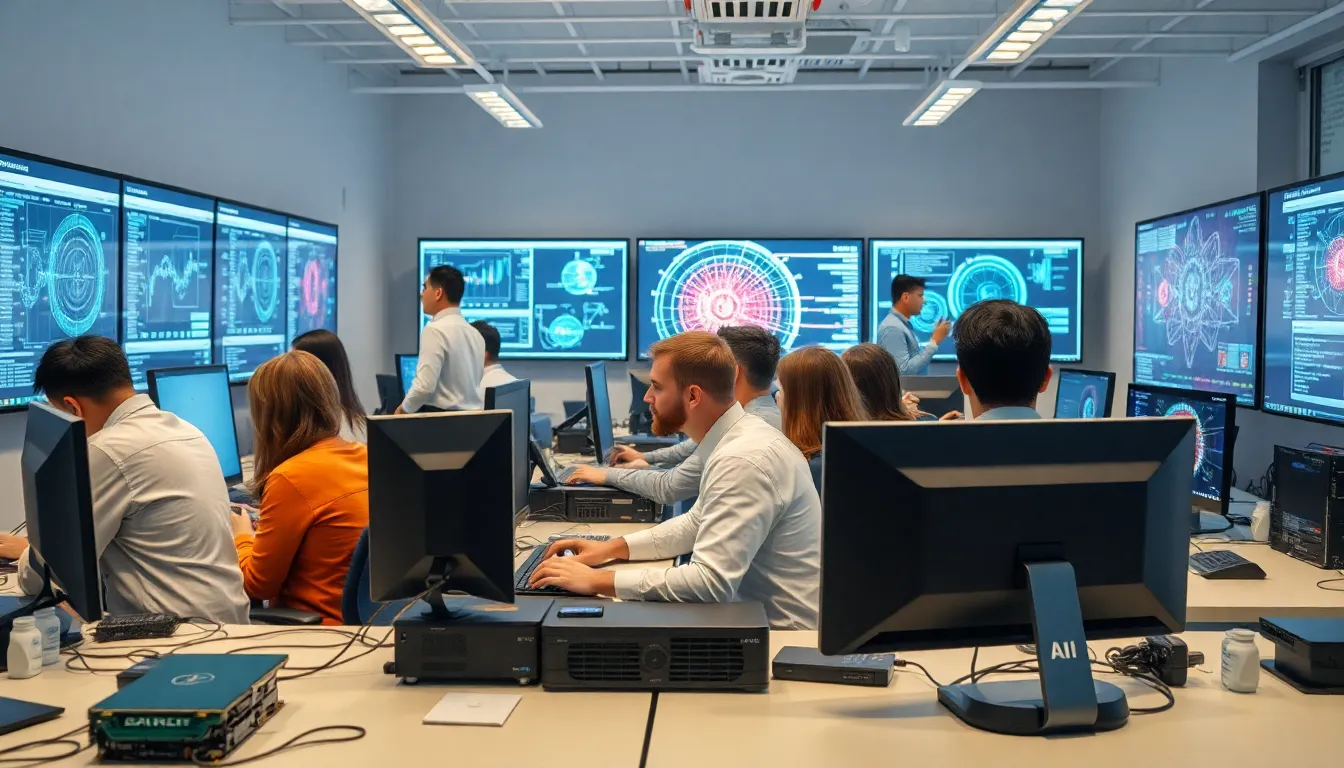Table of Contents
ToggleIn a world where artificial intelligence is no longer just a sci-fi fantasy, AI ecosystems have emerged as the bustling cities of innovation. Picture this: a vibrant marketplace where algorithms trade ideas, data flows like coffee in a hip café, and robots are the new baristas. These ecosystems aren’t just tech jargon; they’re the backbone of modern industries, powering everything from smart homes to autonomous vehicles.
But what makes these ecosystems tick? It’s not just about fancy machines and algorithms; it’s about collaboration, creativity, and a sprinkle of chaos. As businesses scramble to harness AI’s potential, understanding these ecosystems becomes crucial. Dive into the fascinating world of AI ecosystems and discover how they’re reshaping our future—one byte at a time. Get ready to laugh, learn, and maybe even marvel at how far we’ve come.
Overview of AI Ecosystems
AI ecosystems consist of diverse components that collaborate to foster innovation and development. These components include technology providers, research institutions, businesses, and end-users. Each entity contributes unique expertise and resources, creating an environment where artificial intelligence can flourish.
Collaboration forms the backbone of these ecosystems. Industry partners and academic researchers often team up to advance AI capabilities. This synergy enables rapid advancements in fields such as healthcare, finance, and transportation. For instance, startups and established companies alike leverage AI to improve services and products, creating competitive advantages.
Another crucial aspect involves data sharing. Data acts as the lifeblood of AI, fueling machine learning algorithms. Organizations that prioritize open data and interoperability increase their chances of success in this landscape. They can build more robust AI applications that adapt to user needs effectively.
Moreover, regulatory frameworks shape AI ecosystems. Policymakers play a vital role in establishing guidelines for ethical AI development and deployment. Clear regulations inspire trust among users while ensuring that technologies adhere to societal values.
Innovation trends also drive these ecosystems. Emerging technologies such as edge computing and quantum computing enhance AI capabilities. Such advancements impact sectors like manufacturing and energy, enabling smarter operations and reduced costs.
Ultimately, recognizing the interconnectedness of each ecosystem component proves essential. Understanding how these elements interact reinforces the significance of collaboration, data sharing, and innovation in driving AI’s potential across various industries.
Key Components of AI Ecosystems


AI ecosystems are composed of various essential elements that contribute to their overall functionality and success. Understanding these components provides insight into how AI technologies integrate and evolve.
Data Infrastructure
Data infrastructure serves as the backbone of AI ecosystems. High-quality data enables effective machine learning algorithms to train and optimize. Organizations emphasize the importance of open data initiatives and robust data governance frameworks. Efficient data pipelines ensure seamless data flow, promoting accessibility for researchers and developers. Solutions like cloud storage and data lakes facilitate collaboration across institutions. Well-structured data architecture accelerates innovation by making it easier to analyze and derive actionable insights.
Algorithm Development
Algorithm development drives the intelligence behind AI applications. Researchers and engineers focus on creating models that solve complex problems in real time. Techniques like natural language processing and computer vision play a vital role in enhancing user experiences. Continuous refinement of algorithms ensures they adapt to new data and scenarios. Organizations invest in talent skilled in AI techniques, fostering a diverse range of approaches to problem-solving. A collaborative spirit among various stakeholders brings fresh perspectives that enhance algorithm effectiveness.
Hardware and Software Integration
Hardware and software integration is crucial for efficient AI performance. Advanced hardware platforms, like GPUs and TPUs, enable faster processing of large datasets. Software frameworks, including TensorFlow and PyTorch, streamline model development and deployment. Compatibility between hardware and software solutions enhances system efficiency and reduces latency. Organizations prioritize selecting the right combinations to meet specific application requirements. By closely aligning hardware capabilities with software needs, businesses can maximize their AI investments and outcomes.
Major Players in AI Ecosystems
AI ecosystems thrive on a diverse range of contributors shaping the landscape of artificial intelligence.
Tech Giants
Tech giants lead the charge in AI innovation and implementation. Companies like Google, Amazon, and Microsoft invest heavily in research and development. Their vast resources allow for advancements in machine learning, natural language processing, and computer vision. These corporations create comprehensive platforms that support developers, enabling third-party integrations and applications. Collaboration with startups and universities often occurs, fostering an environment rich in innovation. They also engage in various partnerships to expand their AI capabilities, ensuring a steady flow of new ideas and technologies.
Startups and Innovators
Startups play a pivotal role in driving creativity within AI ecosystems. Smaller companies often introduce groundbreaking solutions tailored to specific problems. Many focus on niche markets, addressing needs overlooked by larger competitors. These innovators frequently utilize agile methodologies, allowing for rapid development and pivoting as required. Additionally, investors increasingly back promising startups, providing the capital necessary for growth. They engage in collaborations with established tech giants and research institutions, creating synergies that enhance both parties’ contributions to AI advancements.
Challenges Facing AI Ecosystems
AI ecosystems face several challenges that impact their efficacy and growth. Understanding these hurdles is essential for stakeholders aiming to leverage AI effectively.
Ethical Considerations
Ethical implications loom large in AI ecosystems. Developers confront concerns related to bias in algorithms, which can result in unfair treatment of individuals in crucial decisions like hiring and financing. Transparency must underpin AI systems, ensuring that users understand how data is processed and interpreted. Companies that prioritize ethical AI practices foster trust among users, enhancing their engagement with technology. Stakeholders increasingly demand accountability from those managing AI systems, creating pressure to adopt fair practices that consider societal impacts.
Resource Allocation
Resource allocation remains a significant challenge in AI ecosystems. Organizations often compete for limited access to high-quality data and advanced computing resources, creating disparities in innovation capabilities. Effective collaboration between startups and established companies can facilitate resource sharing, though this isn’t always easy. Businesses with ample resources frequently dominate the AI landscape, overshadowing smaller players that contribute unique solutions. Optimal distribution of funding toward diverse research projects encourages innovation, but misallocation often hampers progress in underserved areas.
Regulatory Issues
Regulatory issues complicate the growth of AI ecosystems. Governments grapple with creating frameworks that protect users while fostering innovation. Existing regulations may not cover rapidly evolving AI technologies, leading to uncertainty among businesses. Compliance with diverse legal standards poses a challenge for organizations operating globally. Companies often express the need for clear guidelines to navigate ethical AI development and application effectively. Balancing regulation with the freedom to innovate is crucial for setting the foundation for sustainable AI ecosystems.
Future Trends in AI Ecosystems
AI ecosystems continue to evolve, influenced by technological advancements and collaborative frameworks. These trends shape how businesses engage with artificial intelligence and maximize its impact across industries.
Evolving Technologies
Automation technologies advance rapidly, transforming workflows and enhancing efficiency. Quantum computing offers unprecedented processing power, catalyzing breakthroughs in machine learning and data analysis. Edge computing improves real-time processing capabilities, allowing devices to perform AI tasks locally, reducing latency. Moreover, the rise of 5G technology accelerates data transfer speeds, empowering AI solutions in sectors like healthcare and transportation. Furthermore, natural language processing advancements enable machines to understand and respond to human language more precisely, enhancing user interactions. Each of these technologies contributes to more responsive and intelligent AI ecosystems.
Collaborative Models
Collaborative models emerge as central to AI ecosystem growth. Businesses leverage partnerships with research institutions to access expertise and pioneering technologies. Open-source initiatives encourage developers to share algorithms and datasets, promoting transparency and accelerating innovation. Industry consortia form, allowing competitors to work together on challenges like ethical AI and data resource sharing. Additionally, digital platforms facilitate collaboration among startups, tech giants, and academic institutions, creating vibrant ecosystems that nurture creativity. With shared knowledge and resources, participants enhance their AI capabilities while driving collective advancements.




